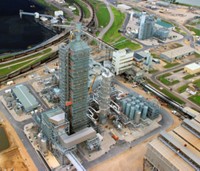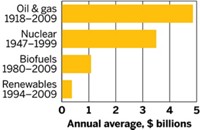Advertisement
Grab your lab coat. Let's get started
Welcome!
Welcome!
Create an account below to get 6 C&EN articles per month, receive newsletters and more - all free.
It seems this is your first time logging in online. Please enter the following information to continue.
As an ACS member you automatically get access to this site. All we need is few more details to create your reading experience.
Not you? Sign in with a different account.
Not you? Sign in with a different account.
ERROR 1
ERROR 1
ERROR 2
ERROR 2
ERROR 2
ERROR 2
ERROR 2
Password and Confirm password must match.
If you have an ACS member number, please enter it here so we can link this account to your membership. (optional)
ERROR 2
ACS values your privacy. By submitting your information, you are gaining access to C&EN and subscribing to our weekly newsletter. We use the information you provide to make your reading experience better, and we will never sell your data to third party members.
Energy
Incentives Boost Coal Gasification
Higher energy prices are making technologies to gasify the nation's vast coal reserves attractive again
by Glenn Hess
January 16, 2006
| A version of this story appeared in
Volume 84, Issue 3
When Congress approved a broad overhaul of U.S. energy policy last summer, chemical manufacturers were disappointed that the measure offered no immediate relief from soaring natural gas prices and impending supply shortages. But industry officials do believe that provisions in the legislation intended to jump-start a new generation of clean-coal projects may be part of a longer term solution to the problem.
U.S. chemical producers rely on abundant, affordable supplies of natural gas to heat and power facilities and to use as a raw material for thousands of consumer and industrial products. But quadrupling of domestic gas prices in recent years is forcing some U.S. manufacturers to move production capacity overseas to countries where low-cost gas can still be obtained.
Since 2001, 95% of all new electric utility plants built in the U.S. have been natural-gas-powered facilities, greatly increasing demand for the clean-burning fuel. At the same time, Congress has refused to lift a moratorium that has kept 85% of the U.S. coastline off-limits to new oil and gas drilling for more than two decades. As a result of the growing imbalance in supply and demand, chemical makers are now paying the highest natural gas prices in the world.
"It makes no sense to build new chemical facilities in the U.S. when raw materials are significantly cheaper abroad," American Chemistry Council (ACC) President Jack N. Gerard told a panel of the House Resources Committee in November 2005. The U.S. chemical industry has lost $50 billion in business to overseas operations and more than 100,000 jobs since natural gas prices began climbing in 2000, according to the industry group. So far, more than 100 chemical facilities have been forced to close in the U.S. "Policies that drove utilities to switch much of their power-generating capacity from coal to natural gas have turned out to be the straw that broke the camel's back," Gerard declared. "From a policy perspective, what is most obvious to us is that new sources of supply are needed to meet the new sources of demand."
Industry officials say steps must also be taken to diversify the nation's fuel supply in general and, more specifically, to slow demand for natural gas by the utility sector. "It is economically unsustainable to continue policies that drive natural gas demand while simultaneously limiting access to natural gas supplies without providing a balancing energy alternative," Eastman Chemical Chairman J. Brian Ferguson remarked in testimony before the Senate Energy & Natural Resources Committee. One of the best long-term solutions, Ferguson said, is to tap into the U.S.'s vast coal reserves through the use of coal gasification, a technology that turns coal into a synthetic gas that can be used like natural gas.
Eastman Chemical was the first company to operate a commercial coal gasification facility in the U.S. and the first to produce acetyl chemicals from coal. The Kingsport, Tenn., plant began production in 1983 and uses several different technologies, including ChevronTexaco's gasification technology and Eastman-developed chemical synthesis technology. The facility and process are designated an American Chemical Society National Historic Chemical Landmark.
"Based on 20-plus years of operating experience, we believe that coal gasification can be competitive right now," Ferguson said. "As additional commercial-sized coal gasification plants are built, the competitiveness of this environmentally superior technology should become more evident.
"The principal environmental benefits associated with coal gasification are significantly lower air pollution emissions in the short term," Ferguson said, "and more cost-efficient carbon dioxide capture and sequestration in the long term." Because coal gasification is a chemical process, it is possible to remove the sources of many air pollutants-including sulfur dioxide, nitrogen oxides, mercury, and particulate matter-before combustion, he explained, when it is much easier and thus less expensive to do so.
Rather than burning coal directly, gasification breaks down coal, or virtually any carbon-based feedstock, into its basic chemical constituents. In a modern gasifier, coal is typically exposed to hot steam and carefully controlled amounts of air or oxygen under high temperatures and pressures. Under these conditions, carbon molecules in coal break apart, setting off chemical reactions that typically produce "syngas," a mixture of carbon monoxide, hydrogen, and other gaseous compounds.
Coal gasification is not a new technology. The first instances of gasifying coal date to the late 1700s, when it was part of a method for making tar. By the start of the 20th century, the streetlights in many of the U.S.'s largest cities were fueled by "town gas," the product of early and relatively crude forms of coal gasification. The technology improved in the 1920s and '30s, yielding more gas and less coke. But once vast fields of natural gas were discovered and pipelines were built to transport the cheaper and cleaner fuel to consumers in the 1940s and '50s, the use of town gas was phased out.
The energy crisis of the 1970s sparked renewed interest in producing fuels from coal and other minerals. But the spike in oil prices was too short-lived, and the push for alternative energy sources died out. The technological development continued, however, and by the 1990s, the Department of Energy began funding coal gasification research as a possible way to reduce carbon dioxide emissions from power plants. The program was also part of an effort to promote the first true commercial-scale integrated gasification combined-cycle (IGCC) coal power plants in the U.S. IGCC systems combine a coal gasification unit with a gas-fired combined-cycle power generation unit. Two such facilities, heavily subsidized by DOE, came on-line in the mid-1990s: the Wabash River Coal Gasification Repowering Project located outside West Terre Haute, Ind.-a joint venture between Dynegy Power Corp. and PSI Energy Inc.-and Tampa Electric Co.'s Polk Power Station near Mulberry, Fla. Both plants lay claim to being the cleanest coal-fired generators in the world.
Although these demonstration projects have established coal gasification as a viable, clean electric-power-generating option, the facilities are more expensive to build than conventional coal-fired plants, because the technology is new and construction and operating uncertainties raise financing costs. To stimulate private investment in gasification and ultimately ease the pressure on natural gas prices, chemical manufacturers and other energy-intensive industries joined forces to persuade Congress to include a package of tax credits and federal loan guarantees in the energy bill. IGCC and industrial gasification projects are both eligible for a 20% investment tax credit, with up to $800 million available for IGCC and up to $350 million for industrial gasification. Federal loan guarantees can cover up to 80% of construction costs.
"We support increased investment in gasification for two reasons," says Owen A. Kean, ACC's senior director for energy policy. "It has tremendous potential to displace natural gas consumption by power utilities, and synthesis gas can be used to make competitively priced chemicals. Both benefits will, over time, help make the domestic chemical industry more competitive in global markets."
In general, Kean says, coal gasification is competitive with natural gas when gas prices are in the range of $3.50 to $4.00 per million Btu. Many energy experts, including those at DOE's Energy Information Administration, now predict that natural gas prices will remain well above $5.00 per million Btu through most of this decade. February natural gas futures recently settled at $9.499 per million Btu on the New York Mercantile Exchange after a mild start to winter in the U.S. helped push the contract price 40% below its peak of $15.78 on Dec. 13, 2005.
"The chemical industry is looking at coal gasification as a demand-side fuel- and feedstock-diversity action," adds Lynn L. Schloesser, legislative counsel for Eastman Chemical. "If we can get off natural gas and substitute syngas, it will benefit all Americans. The more demand reduction there is from industrial consumers, the more the price of natural gas should drop, which would benefit residential consumers who use gas to heat their homes."
Kean says the incentives passed by Congress "have the potential to kick-start a gasification industry in the U.S. if they are fully implemented." He notes that the Treasury Department is scheduled to issue guidance next month describing what companies need to do to qualify and be considered for the investment tax credits. "We believe that if those tax credits are structured properly, they will lead to investment projects taking off in the next couple of years," Kean says.
Under the new energy policy law, industrial gasification projects can receive federal loan guarantees in two ways. One is with a "front-end payment" from the project sponsors. The other is with an appropriation by Congress through the federal budget process. "Either way the dollars are set aside, they must be sufficient to cover an expected default risk, and a process must be put in place to calculate that risk," Schloesser explains. Such a process will take time, he says, "but a process for front-end payments could be developed quickly for projects with sponsors with the right credit."
On the other hand, the tax credits will be available as soon as programs are established for applying the credits. The law directs Treasury to establish the investment tax credit program within tight deadlines. As a result, Schloesser says, the tax credit "is probably the most stimulating. It's real money already laid out there for award to qualified, certified applicants."
Several loan guarantees in the energy bill were earmarked for specific projects, such as $800 million for Excelsior Energy's Mesaba Energy Project, a coal gasification plant that will be built near the town of Hoyt Lakes in Minnesota's taconite mining region. "There is another section in the bill that authorized loan guarantees for qualifying industrial gasification projects that will make fertilizer, chemicals, and other products," Kean notes. "So they tried to spread out the loan guarantees to several different industries."
Sen. John D. Rockefeller IV (D-W.Va.) was the lead author of the Senate provision on clean-coal incentives. New gasification plants would generate greater demand for West Virginia's abundant coal resources. "At a time of turmoil in the international energy markets, we need to find every opportunity to expand our domestic energy production," Rockefeller commented during Senate debate on the energy bill. "Clean coal has to be part of that solution."
Not all lawmakers supported the taxpayer-subsidized loan guarantees. "It's such a terrible precedent, putting taxpayers on the hook for billion-dollar loans to large, successful, private, profitable corporations," said Sen. John E. Sununu (R-N.H.), who tried unsuccessfully to strip the incentives from the legislation on the Senate floor. But Sen. Norm Coleman (R-Minn.) argued that Congress must provide incentives to promote new technologies that will help lower the price of energy. "The Excelsior Energy project will put Minnesota on the forefront of clean-coal technology and again establish our state as a national leader as we seek ways to lessen our dependence on foreign sources of energy through alternate sources," Coleman said.
Kean says the goal of the incentives is to help get a half-dozen or so gasification plants up and running. "From a federal assistance standpoint, this is not something that we would expect to continue for decades," he notes. "We're looking at it as a limited federal involvement for the purpose of helping this technology achieve commercial scale and thereby gain credibility with private investors so that projects will be financed in the future entirely by private capital."
Schloesser says the industrial gasification incentives are warranted by both a "market defect" and a "security vulnerability." The market defect, he explains, is "demand destruction." Globally competitive industries are shutting down production capacity in the U.S. because the supply of natural gas has been limited by a drilling moratorium at the same time that demand for gas from the monopoly power sector has increased dramatically because of environmental and economic regulations. He notes that some analysts project that, by 2010, as many as 1 million jobs could be lost in the U.S. because of natural-gas-related industrial demand destruction.
Another reason that government intervention is justified, Schloesser contends, is security. Energy, chemical, and fertilizer processing plants are concentrated near the Gulf of Mexico, a region vulnerable to natural disasters, as Hurricanes Katrina and Rita have illustrated. Schloesser points out that "4% of all U.S. liquid fuel consumption is by the U.S. military, and nearly all of our food production is dependent on chemicals and nitrogen fertilizers made from natural gas."
Advertisement
From a federal policy perspective, diversification of feedstocks and processing locations for fuels and chemicals would address both the market defect and the security vulnerability, according to the industry attorney. "At the commercial and technological levels, the more certain course for domestic natural-gas-dependent [industries], short of shutdown and shift of production overseas, is to look for and invest in feedstock and process technology substitutes, such as synthetic gas from gasification of coal, petcoke [petroleum coke], biomass, and waste," he says. "Gasification, particularly using a polygeneration scheme-coproduction of power and chemicals-is an economic response that promises to allay domestic concerns about interruptions in U.S. production and consumption of power, food, materials, and fuels."
Schloesser stresses, however, that the technology is not so widely understood at this time as to be supported solely by purely commercial investment. "It is far easier to simply leave the U.S. for cheaper natural gas in other regions of the world and use widely known and understood technologies," he says, noting that having highly efficient coproduction gasification facilities that make power, steam, and chemical feedstocks at one site is not standard.
To overcome the perception of risk, Schloesser says incentives are needed to encourage investment in the U.S. "It's important in the long term to get off natural gas and find substitutes," he says. "The way some chemical companies are doing it is to bring in feedstock or intermediates from offshore. They are shutting domestic facilities down. So it's important, if you want to stay in the U.S. and invest here, to try to accomplish demand reduction through substitution with syngas if you can."
ACC's Kean says several business decisions made in the past year "have fundamentally changed the reputation of the technology in the eyes of investors." American Electric Power Co. (AEP), the nation's largest electricity generator, has announced plans to construct a commercial-scale, 600-MW IGCC power plant in Meigs County, Ohio, and place it in commercial operation by 2010. AEP intends to build at least another 600 MW of IGCC generation in its eastern operating area by 2013. In September, Cinergy Corp. said it would negotiate a contract with General Electric and Bechtel Corp. to conduct a preliminary engineering and design study for a 600-MW IGCC facility at Edwardsport, Ind., or another location.
In November, Peabody Energy Corp., the world's largest coal company, said it would explore sites for a commercial-scale coal gasification plant in Illinois that would convert at least 3 million tons of coal per year into pipeline-quality synthetic gas. ConocoPhillips and Fluor have begun preliminary engineering work for the project. In addition, DOE announced last month that it would partner with AEP, Peabody, and six other private firms to construct the $1 billion FutureGen project, the "cleanest coal-fueled power plant in the world," with a target of zero emissions, hydrogen production, and carbon dioxide sequestration capabilities.
"There's been a tremendous improvement in the future prospects for the technology, and we think there's a big role for it on the industrial side as well," Kean says. "All signs point to this technology gaining commercial acceptance in the power sector, and we would point out that it has equal potential to serve the industrial sector as well."









Join the conversation
Contact the reporter
Submit a Letter to the Editor for publication
Engage with us on Twitter